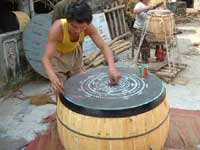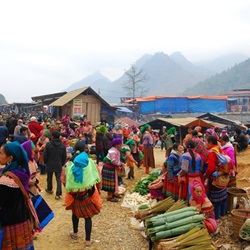There is a village not far from Hanoi but very famous for making traditional drums. It is Doi Tam village in Doi Son commune, Duy Tien district, Ha Nam province.
The drum making craft was first introduced to Giap Ba (present-day Doi Tam) some time in the 8th and 9th centuries under the Dinh-Le Dynasties.
In the year 987, King Le Dai Hanh chose Doi Tam as a place to worship Nguyen Duc Nang - the village genie. The legend says that in 987 King Le Dai Hanh organized a ploughing competition and Nang lost. He was forced to kill a buffalo to treat Doi Tam villagers. Nang then used the buffalo’s skin to make a drum.
The sound of the drum was like thunder and the King then decided to award him the title “Trang Sam” (thunder). Later the locals worshipped him as the village’s drum making genie.
In 1010 King Ly Thai To decided to choose Thang Long (present-day Hanoi) as the capital. On the day the King left Hoa Lu (former capital) in Ninh Binh province for the new capital, all Doi Tam villagers lined the road, beating their drums. Deeply moved by their heart-felt feelings towards him, the King allowed some of them to follow him to Thang Long and they later established a drum making quarter there (now called Hang Trong street).
Growing reputation
Even after the many ups and downs in Vietnam’s history of national development history, Doi Tam village is still able to maintain its traditional craft. At present, the village has 13 drum making enterprises and 14 others that produce skins for the drums. The number of drum makers trained in Doi Tam village has increased from 60 in 2005 to 110 in 2006 and up to 125 by 2007. The village now has two master craftsmen, four senior craftsmen as well as 40 households that are involved in the craft.
The revenue from this craft has also increased significantly from VND2.5 billion in 2005 to VND3.7 billion in 2006 and VND5.3 billion in 2007. On an average, the income per capita for Doi Tam village is VND7.2 million per annum.
In addition, the village has formed a drum playing ensemble, comprising of 60 people, mostly women. The group gives performances both inside and outside the province.
To mark the 990th anniversary of Thang Long – Hanoi in 2000, the former Ministry of Culture and Information chose Doi Tam village to make a special set of drums for the event. The biggest drum, 2.65 m high and 2.01m wide, is now on display at Van Mieu Temple of Literature in Hanoi.
Hanoi will celebrate its 1,000th founding anniversary in 2010 and Doi Tam has again been chosen to make drums for the event. But the size of the biggest drum will be much bigger with a height of over 3m and a width of 2.6m.
In 2007, Doi Tam was officially certificated as a traditional craft village by the Ha Nam Provincial People’s Committee. On November 14, the village was selected as one of the 10 craft villages representing more than 2,000 craft villages nationwide to participate in the national exhibition “The vitality of traditional Vietnamese craft villages” in Hanoi. Six days later, it was presented with the 2007 Best Craft Village Award presented by the Association of Traditional Craft Villages.
Future vision
From being a village that produced drums on a small scale only, Doi Tam has step by step gained a reputation for its high quality drums inside and outside the country. Its drums are now sold in Laos, Cambodia, the Republic of Korea, Japan and the USA.
In addition to its traditional products, the villagers have now diversified their products, which include wooden tubs and wine containers.
At present, some 520 people from Doi Tam are making drums far away from home, including the artisans Pham Chi Thinh in Ho Chi Minh City and Pham Van Thuan in Hanoi.
According to drum making expert Pham Chi Quang, it requires a lot of effort to make a drum. The whole process is divided into eight stages. The first stage is to make the frame made from the jackfruit tree. It is followed by making the membrane which must be made from an old buffalo skin.
If you visit any workshop that makes drums, you’ll witness the whole production process, which involves 15-20 workers doing different things at the same time.
Dinh Van Luong, the village chief says “In the next few years, we’ll move all the workshops to a new craft complex. We also plan to produce some other traditional musical instruments in addition to drums to sell on the domestic and international markets”.
Source: VOV









.png)










COMMENTS